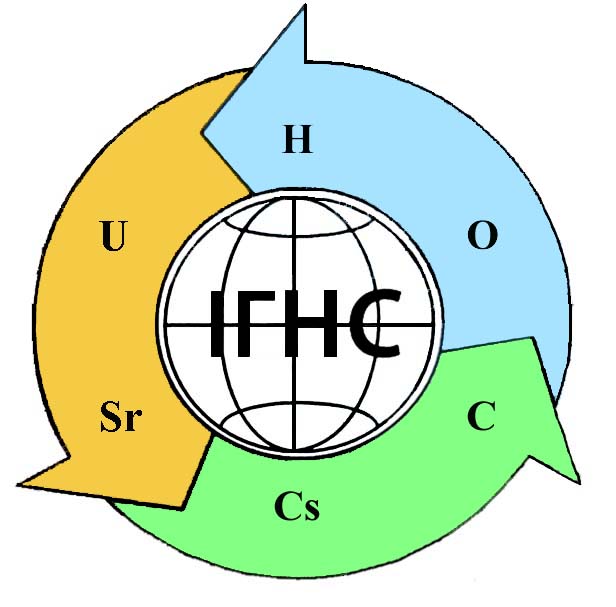DETRITIZATION OF AQUEOUS SOLUTIONS USING HIBSITE
DOI:
https://doi.org/10.32782/geotech2022.35.04Keywords:
tritium, hydrogen, heavy hydrogen isotopes, hibsite, adsorption, fractionationAbstract
An important task in protecting the environment from tritium pollution is to find effective, simple, affordable, low-cost and low-energy methods for extracting tritium from large volumes of low- and intermediate-level aqueous solutions. The article presents new data on the influence of the octahedral component of the structure of layered silicates on the extraction of tritium from aqueous solutions obtained using research on an experimental stationary system on the example of the natural mineral hibsite. The possibility of using hibsite as a natural adsorbent of tritium is considered. The degree of adsorption of tritium from an aqueous solution and the effect of fractionation of hydrogen isotopes in the stationary system "HTO-hibsite" were estimated. The mechanism of tritium retention in the structure of the natural adsorbent is explained. Tritium extracted from tritiated water is distributed in the mineral matter between different structural positions – with the lowest binding energy in the HTO molecular form in surface adsorbed moisture (1 fraction), with slightly higher – in -OT ionic form in the structural positions of the mineral adsorbent (2 and 3 factions). Up to 39% of the total amount of tritium extracted from the aqueous solution is retained in hibsite in a surface adsorbed form. The predominant retention of polarized HTO molecules, compared to H2O molecules, near the mineral surface due to dynamic adsorption-desorption processes causes the effect of fractionation of hydrogen isotopes (α = 1.14). The exchange between the OH groups of the structural Al-hydroxyl layers of the mineral and the OT groups of tritiated water leads to the fixation of up to 55% of tritium in this form. New scientific results on the influence of structural and physicochemical properties of the studied mineral adsorbent on its ability to extract tritium from aqueous solutions and new data on the peculiarities of the mechanism of interfacial isotope-hydrogen exchange in a water-mineral system provide, together with the results of our previous studies, more effective development of methods for detritization of aqueous solutions.
References
Belovodskyy L.F., Haevoy V.K., Hryshmanovskyy V.Y. Trytyy. Moskva: Enerhoatom, 1985. 247 p.
Brindley G. W. and Nakahira M. (1959). Zeitschrift fur Kristallographie, Bd. 112. 136-149. https://doi.org/10.1524/zkri.1959.112.jg.136
Deer W.A., Zusman J., Howie R.A. Rock-forming minerals. Mir, Moscow, 1965, T. 5, Nesilikatnye minera., 404 p.
Lopez-Galindo A., Hach-Ali P. F., Pushkarev A.V., Lytovchenko A.S., Baker J.H., Pushkarova R.A. (2008). Applied Clay Science, v.39, p. 151–159.
Lytovchenko A.S., Pushkarev A.V., Samodurov V.P., Baker J.H., Hach-Ali P. F, Lopez-Galindo A., (2005). Mineralogical Journal. N 2. p. 59-65.
Nesmeyanov A.N. Radiochemistry. Moscow: Chemistry, 1972. 591 p. [in Russian
Pushkarev O.V., Dolin V.V., Pryymachenko V.M., Bobkov V.M., Pushkareva R.A. (2007). Zbirnyk naukovykh pratsʹ Instytutu heokhimiyi navkolyshnʹoho seredovyshcha. Vyp.15. pp.27-36
Pushkarov O. V., Rudenko I. M., Dolin V. V. (mol.), Pryjmachenko V. M. Sepiolit-ceolitovi kompozyty jak potencijni vodopronykni reakcijni bar’jery. Zbirnyk naukovyh prac'. Instytut geohimii' navkolyshn'ogo seredovyshha. Kyi'v, 23, 98 -107. (2014)
Pushkarov O.V., Lytovchenko A. S., Pushkar'ova R. O., Jakovljev E. O. (2000). Mineral'ni resursy Ukrainy. Kyi'v, 3, 42-45.
Pushkarov O.V., Pryjmachenko V. M. (2010). Zbirnyk naukovyh prac', Instytut geohimii' navkolyshn'ogo seredovyshha. Kyi'v, 18, 149-156 pp.
Pushkarov O.V., Pryjmachenko V. M. (2010). Zbirnyk naukovyh prac'. Instytut geohimii' navkolyshn'ogo seredovyshha. Kyi'v, 18, 140-148.
Pushkarov O.V., Pryjmachenko V. M., Zolkin I. O. (2012). Zbirnyk naukovyh prac'. Instytut geohimii' navkolyshn'ogo seredovyshha. Kyi'v, 20, 98 -108.
Pushkarov, O.V., Rudenko, I.M, Skrypkin, V. V. (2016). Visnyk of Taras Shevchenko National University of Kyiv. Geology, 71, 43-48. https://doi.org/10.17721/1728-2713.71.07
Tarasevich Ju.I. (1988). Kyiv, Naukova Dumka, 248 p.
Wypych Fernando (2009). VII – caulinita e haloisita. Available at: https://www.researchgate.net/figure/Figura-4-Figura-4-Estrutura do-tipo-brucita-A-e-do-tipo-gibbsita-B-com-vista_fig2_292726910









